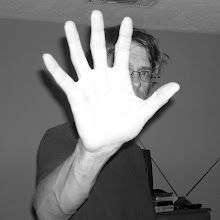I've had a fascination with Batman all my life. As a little kid Batman was my favorite superhero, due mainly to the syndicated re-runs of the campy Adam West TV series. Once I started reading comics, however, my tastes moved toward the Marvel universe. I rarely bought a Batman comic (the Batman comics of the time seemed dull compared to the exciting world of Marvel). Still, I had an interest in Batman. The "idea" of Batman--the ultimate detective and perfect vigilante--always seemed bigger and more promising than anything the comics or movies could offer.
Batman may be the most serious comic book "hero" of all time (a fact searingly proven to the masses by Christopher Nolan's The Dark Knight). He is a character with a complex and troubled psyche. He is brilliant and he is driven. He embraces both the technological and the mystical. He is distinctly not "super." He is perhaps the one comicbook character who I--as an adult--still find compelling.
And, as an adult, I have been drawn to the occasional Batman comic. Such was the case a few months ago when I walked into my local comic shop and saw that Neil Gaiman had scripted a two-part Batman story, "Whatever Happened to the Caped Crusader?" Ignorant of the current state of the Batman universe I quickly learned that Batman (i.e., Bruce Wayne) had died and this was Gaiman's brief contribution in a plethora of new story concepts surrounding the death. (Batman/Bruce Wayne will not stay dead, of course. He is as dead as Superman was. As dead as Captain America. Registered trademarks do not die. . . . At least not for very long.)
A fan of Gaiman's comic work, I picked up his two issues of Batman (Batman 686 and Detective Comics 853, both drawn by Andy Kubert). Then I noticed the new Batman and Robin series by writer Grant Morrison and artist Frank Quitely. And who could miss the new Batwoman story in Detective Comics by writer Greg Rucka and artist Stephen Williams III? Before I knew it I was home eagerly reading five new Bat-comics.
The Gaiman story was excellent. A disembodied Batman watches his own funeral as each person who eulogizes him claims to have killed Batman or been the cause of his death. In effect, we are seeing a number of alternate possibilities as to what Batman means to people. Perhaps the most fascinating "possibility" is Alfred's story in which the loyal butler claims to be the Joker (he dressed up as the arch villain to provide an adversary for Batman and thereby mitigate Bruce Wayne's mental instability). Gaiman two-issue story was a very nice, self contained tale. Highly recommended.
The new Batman and Robin was also quite good. I love Frank Quitely's art and his work on this series is gorgeous. Morrison tells a good tale and manages to create a genuinely disturbing character in Pyg. I can't remember the last time I encountered such a gruesome and unsettling villain in a "mainstream" comic. This certainly isn't kid stuff. The other characters are also handled well though the Batman and Robin dynamic seems uninspired (Robin is rather boring as a compulsive brat whom Batman has to keep "teaching lessons"). Still, it's too soon to pass judgment; the book has just started and there are plenty of directions this relationship could go.
The Batwoman story in Detective Comics 854 is also just getting started but from what I've seen so far this may be something special. The art by J.H. Williams III is stunning. His sharp, forceful panels are mesmerizing (to say the least) and the way Batwoman is rendered in black, white and red by colorist Dave Stewart is beautiful. Usually I don't find the female versions of established characters that interesting; Batgirl, Supergirl, She-Hulk, Spiderwoman--they always seem like afterthoughts, just another way to take advantage of the Bat-, Super-, Spider- prefixes. (Or -Hulk suffix--you couldn't have a Hulkwoman, could you?) I'll admit I know next-to-nothing about the new Batwoman's backstory (she's been kicking around the DC universe for some time) but Rucka and Williams have obviously put some effort into making the character intriguing and unique. Her brief interaction with Batman provided an effective contrast between newcomer and legendary counterpart, a point further emphasized by the issue's memorable final panel. Batwoman has a lot of potential and I eagerly await the next issue.
So I'm reading Bat- stories again. I'm seriously psyched. Enough to dig out Frank Miller's first Dark Knight series (please, let's forget the second one) and Batman: Year One and Alan Moore's The Killing Joke and some Matt Wagner stories. Oh, and I just bought Batman: The Long Halloween. I feel like a kid again. It's great!
19 hours ago



Grant Morrison is easily my favourite comic writer probably ever. He has a ridiculous imagination. If you continue the Bat-binge, check out his previous work on the title, "Batman and Son", "The Black Glove", and "Batman RIP", but also check out stuff like "All-Star Superman" as well as his less mainstream work such as "The Invisibles", which is incredible.
ReplyDeleteI loved the Gaiman story, too. Dare I admit I may have even gotten a little teary.
Tom,
ReplyDeleteI have the first half of All Star Superman and plan on getting the second hardcover soon. I will look for the other Batman titles you mentioned. Thanks!
In case you're unaware - Grant Morrison described Batman & Robin as if "David Lynch were doing the old Batman TV show".
ReplyDelete